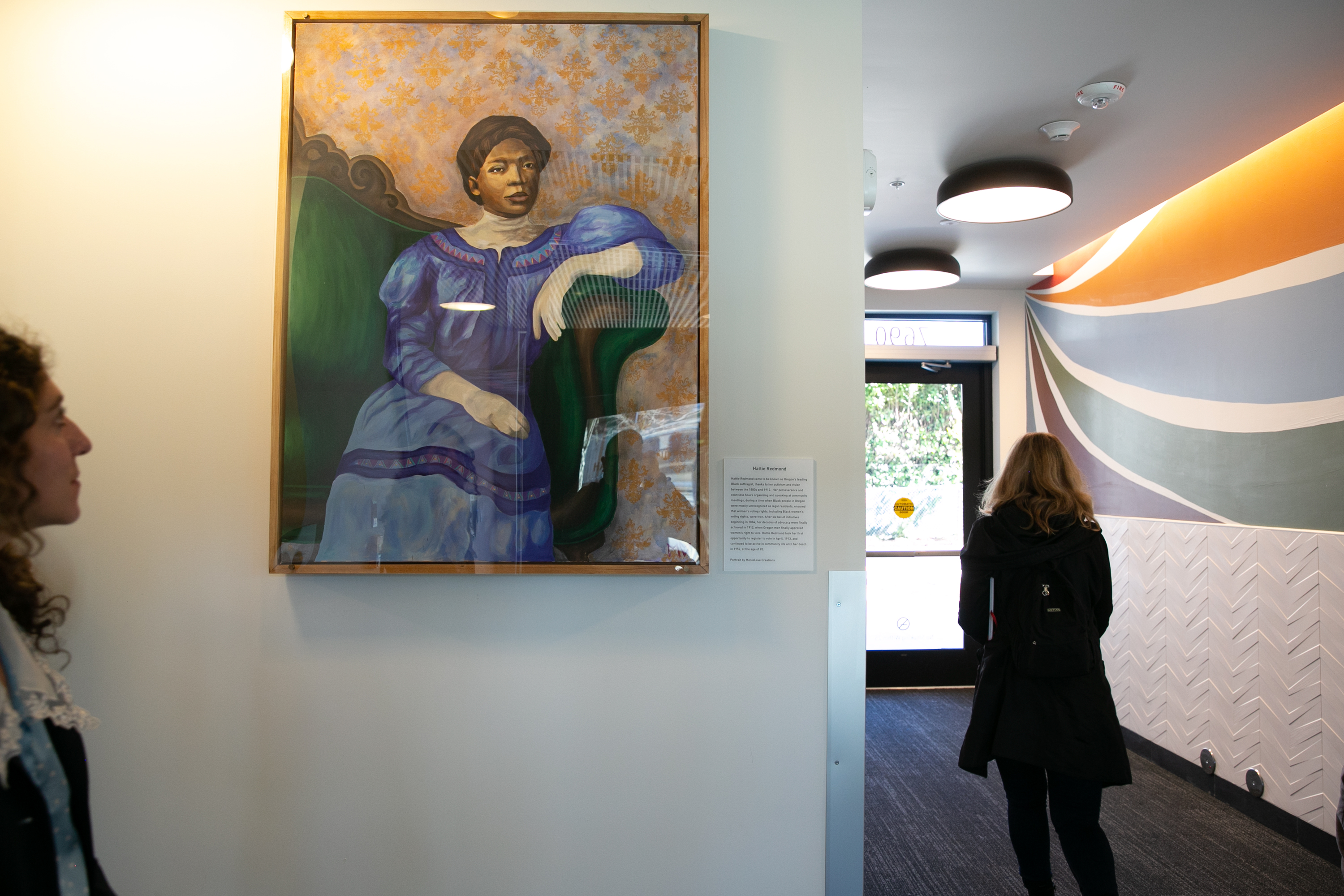
In this 2023 photo supplied by Multnomah County, people tour the Hattie Redmond Apartments. The 60-unit permanent supportive housing community for people exiting homelessness, is located in Portland’s Kenton neighborhood in North Portland and designed for those with disabilities who request access to culturally specific services within the Black community.
Courtesy of Motoya Nakamura / Multnomah County
Editor’s note: Throughout 2023, OPB is taking a deep look at the biggest social and economic challenges facing Oregon today – their origins, their impacts and possible solutions. This week, we’re looking at the root causes of and possible solutions to homelessness. Read part one here.
For Ilene Burns, a room in a permanent supportive housing apartment complex in North Portland was her path out of homelessness.
Burns, 60, became homeless in Portland after her husband died unexpectedly in 2019. She spent three years sleeping in a car or on a sidewalk, waiting for her name to come up on a list for supportive housing. It can regularly take up to five years for unhoused people to receive this kind of housing in Portland.
“I’m not going to lie. It was scary for a single woman living by herself,” Burns said. “I was so afraid of closing my eyes at night. I pretty much just kept to myself. And I just prayed.”

Ilene Burns says that access to permanent housing has helped her start the healing process from trauma experienced in homelessness.
Caden Perry / OPB
Across Oregon, there are thousands of people like Burns, whose individual stories of housing instability are often invisible – even as the political discourse around homelessness takes center stage. The solutions to the state’s homelessness crisis aren’t uniform, as they need to be tailored to each person’s specific needs. And any fixes will take collective action, public investment and considerable time to achieve, making the work anything but simple.
Permanent supportive housing is a model that combines housing with any support services that someone who has been homeless for a long time may need to stay housed. That could include anything from job training programs to on-site substance abuse treatment to child care.
Burns moved into her supportive apartment complex, called the Hattie Redmond, in March. Since then, staff have helped her get new identification cards to replace ones she lost when her wallet was stolen while she lived outside. They’ve helped her with the expungement process to clear her criminal record – a 2014 charge for not paying transit fare – and are now laying the groundwork for Burns to apply for nursing school.
“We check in every other week to see where I’m at with my goals,” Burns said.

The Hattie Redmond Apartments, a 60-unit permanent supportive housing community for people exiting homelessness, in Portland’s Kenton neighborhood.
Courtesy of Motoya Nakamura / Multnomah County
Permanent supportive housing is one of many solutions working to address Oregon’s homelessness crisis, where nearly 18,000 Oregonians lived without housing in 2022. While most agree that Oregon’s housing shortage is the clear cause of the state’s surging homelessness crisis, it could take decades to resolve. In the short-term, solutions like supportive housing, shelters, villages and rent support offer temporary – and permanent – refuge. While data is limited on the success of these relatively new solutions, it’s clear that they help pave the way out of Oregon’s homelessness crisis.
Burns now sleeps in her own studio apartment just across the street from the sidewalk that she used to call home. A sign reads “Home Sweet Home” at the entrance, and her small terrier, Teddy, greets her energetically when she unlocks the door. Photos of her late husband and children decorate the walls.
“I couldn’t tell you enough how comfortable I am here,” Burns said in July, four months after moving in. “I don’t have to worry about nothing. I’m not scared anymore. This is my home.”
Permanent supportive housing is a relatively new approach to ending homelessness. It grew out of a widespread solution to homelessness called “housing first,” which prioritizes moving unhoused people into housing before addressing other needs. After research found that housing alone isn’t enough to end homelessness, governments began investing in programs that partner housing with hands-on support.
The Hattie Redmond is operated by the Urban League of Portland, a nonprofit centered on empowering Black Portlanders, and Home Forward, Multnomah County’s public housing authority. It’s funded by a regional income tax approved by voters in 2020, which focuses specifically on financing these types of programs.
“Permanent supportive housing is the opportunity to serve people on a deeper level and get to the root cause of some of the issues,” said Leor Beverly, a housing program manager at Urban League. “We address the trauma, we address the damages, and it’s a place for people to feel safe.”
But it’s not the solution for everyone. Beverly said some people aren’t comfortable moving directly from the streets to an enclosed apartment complex. That’s when other solutions come in.

Delanya Clarkson straps on a harness to her dog, Rotsky, on the deck of her Opportunity Village home in Eugene, Ore., on Aug. 31, 2023.
Caden Perry / OPB
Delanya Clarkson, 49, found her way out of homelessness through a tiny home shelter program called Opportunity Village. The colorful cluster of 30 sleeping pods is located in West Eugene, and has offered transitional housing to locals for a decade. Tenants originally were responsible for $35 in rent, but they are now only required to work a few hours a week on projects around the village to keep it running – like cleaning bathrooms or operating the front gate.
Tenants have access to free laundry, showers and a communal kitchen, which is regularly stocked with provisions from the Lane County Food Bank. There’s no time limit to their tenancy, as long as they regularly meet with a program housing coordinator to work toward applying to more permanent housing. The program has a two-year-long waitlist.
“This was always intended to be transitional,” said Ian McBride, who works as the shelter coordinator for SquareOne Villages, the nonprofit that operates Opportunity Village.
Clarkson and her ex-boyfriend became homeless when their landlord evicted them following a disagreement in 2021. At the time, Clarkson was addicted to heroin.
“If I had been in my right mind, I would’ve found another place to move into before it got to that point,” said Clarkson, who is now two years sober.
After the eviction, her car broke down, which was her sole way of commuting to work at Southwest Airlines in the Eugene Airport. With an eviction on her record and no income, Clarkson couldn’t find a place to rent.
She spent the following nine months sleeping in the back of her ex-boyfriend’s truck and trying to get help from local housing providers. It wasn’t an easy system for Clarkson to navigate, especially since she had little experience with housing instability. Clarkson, a University of Oregon graduate, was raised in an affluent household with both parents working in high-achieving jobs. Her parents have since passed away.

The new Opportunity Village site in Eugene, Ore., on Aug. 31, 2023. These "bungalow" houses have been upgraded from the other pallet houses and smaller Conestoga pods found in other parts of this village.
Caden Perry / OPB
“I had no idea what I was doing,” Clarkson said. “It was so hard to get anything done, I was in a constant state of worry. I mean, how can you progress without stability? And how can you get stability on the streets? It’s impossible.”
She finally got a call from Opportunity Village that a tiny home had opened up. Life at the village gave her a kind of self-reliance she hadn’t felt for months.
“This place has given me the physical and mental stability that lets me see beyond the scope of just existing,” Clarkson said. “It’s a moment to pause and begin planning my future.”
Since moving in, Clarkson’s applied for a loan to cover her car repairs, and is anticipating returning to her old job. She also has sights on moving into a housing co-operative run by SquareOne Villages, where low-income renters are given the opportunity and support to eventually buy their home.
Others at Opportunity Village are charting similar paths to long-term housing. Misty Wilmarth, who lost her home in the 2020 Holiday Farm Fire along the McKenzie River Highway east of Eugene, is on a list to move into a subsidized apartment. Wilmarth, 43, was living in a tent outside before moving into the village. She said it would have been challenging to seek permanent housing before finding the stability Opportunity Village granted her.
“Before this, I didn’t really have any goals,” she said. “I just knew I needed to get out of a tent. After getting here, I was able to actually collect my thoughts and put together some kind of plan.”
But do these efforts work?
Much of Oregon’s solutions to homelessness are too new to come with clear data proving their success. But early numbers are positive. Since early 2022, the city of Portland has operated several Safe Rest Villages, which are small shelters akin to Eugene’s Opportunity Village. In May, the city reported that more than 50% of all Safe Rest Village residents have moved into stable housing.

The Peninsula Crossing Safe Rest Village is a temporary housing shelter located in North Portland, opened in May 2023.
Kristyna Wentz-Graff / OPB
What is clear is that villages like these are expensive.
The cost to operate one of Portland’s Safe Rest Villages can cost between $40,000 and $64,000 per person each year. That doesn’t include the upfront costs of building each village, which can reach up to $500,000, according to a 2023 analysis by economic consulting firm ECONorthwest. The average cost to run an indoor shelter is about $33,000 per bed annually, according to that analysis. In contrast, the average annual cost to rent a one bedroom apartment in Portland is currently just under $18,000.
National data shows that moving people directly into housing can end homelessness. In 2012, the U.S. Department of Housing and Urban Development offered money and national homelessness experts to Houston, among nine other cities, to address its homelessness crisis. Through rent vouchers and other housing assistance programs, the city has moved more than 25,000 homeless people directly into apartments and housing in the past decade. Nearly three-quarters of those people have remained housed – cutting the city’s homeless population by 63%. And a dedicated investment in permanent supportive housing for veterans helped reduce the United States’ homeless veteran population by 55% since 2010.
A study published by the University of California San Francisco in 2020 found that nearly 90% of all chronically homeless people placed in permanent housing in Santa Clara County remained housed for more than two years.
Other studies show more limited success. In a 2022 analysis of supportive housing programs in the U.S and Canada, Columbia University economics professor Brendan O’Flaherty found that out of 100 people offered permanent supportive housing, 24 people will not return to homelessness.
O’Flaherty concluded that, while supportive housing doesn’t reduce homelessness for every single person who is offered it, there are no other programs proven to do so.
Permanent supportive housing programs also come at a high price. In its latest report on the regional supportive housing tax program, Multnomah County reported spending about $14,800,000 to place 934 people into permanent supportive housing between August 2022 and August 2023.
The high cost can cut public spending in other areas, however. National studies show that permanent supportive housing can also lead to a drop in hospital stays, time in mental health facilities and arrests for recipients.
Other national studies have shown that simply giving people $2,000 to prevent an eviction prevents overall homelessness in that community by nearly 4%.
John Tapogna, a senior policy analyst at ECONorthwest, said that based on existing data, permanent supportive housing and rent support appear to be the most effective tools to reduce and prevent homelessness. But with limited data, it’s hard to predict who might need that assistance – and when. (Tapogna is a member of OPB’s board of directors).
“It’s sort of like we’ve got terrible drought conditions all over our forests, and we have limited money to go out and treat the forest,” Tapogna said. “And we don’t know where the lightning is going to strike.”
Barriers and challenges
Cost isn’t the only barrier to moving people out of homelessness. Often, new shelter programs or villages are hampered by opposition from neighborhood groups or schools, who fear that people experiencing homelessness may be dangerous.

Tents of unsheltered people camping along the Peninsula Crossing Trail are seen through the fencing at the Peninsula Crossing Safe Rest Village, May 18, 2023. The encampment along the trail has since been cleared, but neighbors say the issues seen along the trail are now in the midst of their neighborhood, including theft, open drug dealing, fighting and screaming.
Kristyna Wentz-Graff / OPB
Mismanagement by government agencies and nonprofits tasked with operating these programs can also slow progress. In Multnomah County, government officials sat on more than $40 million in tax dollars meant to support homeless programs for months because of low wages and staffing shortages at the organizations they partnered with to distribute the funding.
Poor staff retention at service organizations can hurt the people they’re expected to serve.
Candi Silvis spent three years living outside in Washington County after leaving an abusive relationship. Silvis, 51, said the biggest barrier to exiting homelessness was navigating the numerous programs and social services, especially due to frequent staff turnover. Silvis said she was forced to start her housing application process over after one case worker quit without anyone alerting her.
“I called him for four months with no answer,” Silvis said. “I just thought, well, he’s obviously ignoring me.”
Silvis eventually received a rent voucher through Washington County – financed through the regional supportive housing services tax – that allowed her to move into a Beaverton apartment in August. That voucher covers rent until she starts bringing in an income that’s more than 30% of the area’s median yearly income, which is a little over $22,000.

Candi Silvis glances at herself in the mirrors in her Beaverton, Ore., apartment on Sept. 1, 2023. Silvis found matching furniture sets to go in her apartment with the support staff that helped her into housing.
Caden Perry / OPB
For some, the housing support they’re offered isn’t enough to leave homelessness behind. Jeff Zumwalt, 68, has lived in Opportunity Village for nine months. He moved to Eugene from California a few years ago to take care of his elderly mother. He became homeless after she died, when he was no longer able to live in her house rent-free.
Zumwalt has chronic obstructive pulmonary disease, an illness which impacts his lungs and heart. This makes it impossible for him to hold a job, let alone walk from his sleeping pod to the bathroom without needing to catch his breath. He lives off a few hundred dollars in social security benefit payments each month.
Since moving into Opportunity Village, Zumwalt has been encouraged to look for permanent housing. But he said that the cheapest option he’s found would cost him around $500 a month in rent. With the additional cost of utilities and groceries, Zumwalt said that price tag “just wouldn’t work out.”
“I’d already be spending half my money on a bag of groceries,” he said. “If it was affordable, I’d move into an apartment. But there’s no way I could pay that.”

Jeff Zumwalt, 68 years old, gets up from his bed in Opportunity Village in West Eugene, Aug. 31, 2023. Zumwalt was one of the first villagers to move to the new site because of his various health issues that prevent him from working.
Caden Perry / OPB
Zumwalt said his doctor told him he has about a year left to live due to his illness. He doesn’t see himself leaving Opportunity Village in that time due to the cost of housing.
Politics also play a direct role in the ability to open new programs. If people hear politicians asking for more money to create supportive housing programs, yet they don’t personally feel like their city’s homeless population has been impacted by this investment, they may be hesitant to sign on. Since the current solutions to homelessness still have a small impact on the state’s overall homeless population, it could take years to see an impact on the number of people living outside.
“If you’re investing in the solutions that bring homelessness down, but people are still seeing the same number of tents in their neighborhoods, you are going to lose political support,” Tapogna said.

Kenny LaPoint is the executive director of Mid-Columbia Community Action Council, a nonprofit providing services to people experiencing homelessness in Wasco, Hood River and Sherman Counties. MCCAC operates a 36-bed non-congregate homeless shelter consisting of tiny homes overlooking the Columbia River in The Dalles.
Sheraz Sadiq / OPB
That’s where city-sanctioned homeless camps come into play. Several Oregon cities, including Portland, have recently invested millions in building spaces where hundreds of people can camp or sleep in a pod while awaiting more permanent shelter or housing. They are meant to interrupt the chaos of sprawling urban encampments.
Marisa Zapata, the director of Portland State University’s Homelessness Research & Action Collaborative, warns against this model. Her research has found that holding more than 30 people in one outdoor village can bring health and safety challenges. But she understands that places like these may be what’s required to get public support.
“The reality is,” Zapata said, “we can just hide people who are unsheltered and people will think it’s successful.”
Criminalization
In lieu of quick solutions, Oregon has historically relied on another tool to address homelessness: Criminalization.
Arresting people for being poor or not having a home began with Oregon’s statewide vagrancy law in 1887. This law charged people with a crime for having “no viable means of living” or begging for money in public. The details of this kind of violation have been softened over the century and complicated by civil rights challenges – but state and local lawmakers have continued to find ways to penalize people who are living without homes.
For decades, cities across Oregon imposed criminal sanctions on people sleeping or sitting in public spaces, like sidewalks or parks.
This pattern was interrupted in 2018, when the Ninth Circuit Court of Appeals ruled that punishing people for sleeping on the street was considered cruel and unusual punishment if they have no other place else to go. This case, Martin v. Boise, impacted states across the entire West Coast, including Oregon.
In 2020, a federal appeals court ruled that Grants Pass’s ordinances banning sleeping outside were unconstitutional under Martin. The city’s appeal may land in the U.S. Supreme Court. Portland and the League of Oregon Cities, a group that lobbies for Oregon municipalities, filed a court brief in September that encouraged the Supreme Court to reconsider this case.
In 2021, the state legislature passed a bill hoping to bring cities into alignment with the appeals court ruling. directing cities to make “objectively reasonable” rules about when and where people could rest on public property. This led cities across Oregon to adopt laws that stretch the definition of “reasonable” by limiting outdoor sleeping to certain times of day and locations. A group of unhoused Portlanders have filed a class action lawsuit against Portland’s version of this policy, which prohibits camping on any public land between 8 a.m. and 8 p.m., among other restrictions. Bend has faced similar legal threats.

FILE - In this aerial photo taken with a drone, tents housing people experiencing homelessness are set up on a vacant parking lot in Portland, Ore., on Dec. 8, 2020. In Feb. 2022, the mayor of Portland, Oregon, banned camping on the sides of certain roadways, and officials are exploring other aggressive options to combat homelessness.
Craig Mitchelldyer / AP
According to the National Homeless Law Center, Oregon is one of the three states that don’t have a state law criminalizing homelessness. But it’s found other ways to penalize people experiencing homelessness at the local level.
In 2017, Eugene Weekly found that a quarter of all people arrested in Eugene in the past year were homeless. These arrests were largely misdemeanors linked to basic survival for people living outside, like trespassing, drinking in public and violating park rules. In 2022, an investigation by Reveal found that, over the course of four years, half of all arrests made by Portland police were of people experiencing homelessness. Like in Eugene, these arrests were mostly tied to low-level violations or bench warrants for missed court appearances
Removing someone experiencing homelessness from the public eye may temporarily appear to erase homelessness, but research shows it only exacerbates someone’s time living unsheltered. A criminal record can be a barrier to housing, employment and public benefits, making homelessness harder to escape.
It’s also costly. In the Oregon Department of Corrections, holding one person in prison costs the state roughly $140 per day – or $51,000 yearly.
Housing, not handcuffs
Housing production remains the clearest way out of Oregon’s homelessness crisis.
According to state analysts, Oregon needs to produce 554,691 new housing units in the next 20 years to keep pace with demand – and to account for the current underproduction. An estimated 32% of those units, or 176,3000, must be affordable to households that are earning less than 60% of statewide median income, which was $70,084 in 2021.
State leadership is listening.
Not long after entering office in January, Gov. Tina Kotek passed an executive order establishing a statewide goal to produce about 36,000 units of housing each year for the next ten years. Months later, state lawmakers passed a $200 million legislative package to help fund new construction, move 1,200 homeless people into supportive housing, fund rent assistance for people at risk of homelessness, and more. Some $26 million of that package is reserved for rural communities, with $80 million going to the state’s most populated regions. The legislation also required cities with a population greater than 10,000 to set targets for building affordable housing to meet future growth needs.

Newly sworn-in Oregon Gov. Tina Kotek signs three executive orders to combat homelessness at the State Library of Oregon in the state capital in Salem, Jan. 10, 2023, her first full day in office. The executive orders declared a homeless emergency in most of the state, increased housing construction targets, and directed state agencies to prioritize reducing homelessness.
Claire Rush / AP
PSU’s Zapata is heartened that state leaders are committed to housing, but she wants swifter action.
“We have to push back on the idea that there’s not enough time or that there’s not enough money,” Zapata said. “We could choose to build things faster.”
Zapata points to the luxury apartments and commercial buildings sitting empty in downtown Portland as properties that could be transformed into public housing.
“Sure, it’s not gonna pencil out financially,” she said. “We just have to decide what we’re willing to sacrifice to make that happen.”
Ed Blackburn is the former director of Central City Concern, a Portland nonprofit that offers residential drug treatment programs to people experiencing homelessness. Blackburn warns against investing solely in housing without the kind of critical addiction recovery programs and mental health care needed to keep some of the most vulnerable Oregonians indoors.
“Decades ago, we had a cross-section of providers working together to address people’s needs,” he said. “That level of sophistication… I don’t see it anymore.”
As state leaders tinker with housing production and other solutions to homelessness, those living outside will continue to try and find a path out.
Silvis hopes to use her newfound stability in her Beaverton apartment to help.
No longer focused on meeting her basic daily survival needs outside, Silvis is interested in helping others stuck in that cycle. She’s planning on starting a group for people currently experiencing homelessness to help them navigate the complicated process of applying for housing programs and other public support.
“I want to give people the kind of support that I needed,” she said. “I want people to know there’s a light at the end of the tunnel. I know people that are housed can do a tremendous amount of good. I know they can, and I know they will.”
This examination of Oregon’s homelessness crisis was written and reported by Alex Zielinski, with photography by Caden Perry and Kristyna Wentz-Graff, edited by Andrew Theen, photo editing by Kristyna Wentz-Graff and produced for the web by Meagan Cuthill. This series exploring both the biggest problems facing Oregon and potential solutions is sponsored by the Oregon Community Foundation. And none of OPB’s journalism happens without you. Help us tell more stories like this one – and ensure stories like this reach as many people as possible – by joining as a Sustainer now.
















